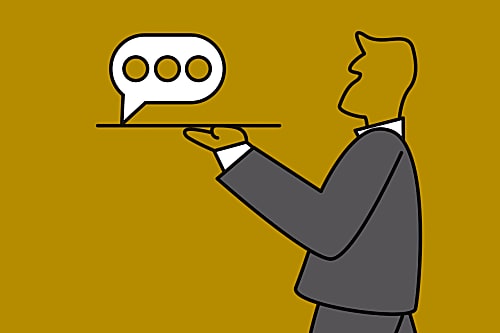We wanted to know how you are managing the ubiquitous messaging tool to save your sanity and keep things productive.
Over the past ten years, Slack has almost single-handedly changed the landscape of workplace communication. It has helped reduce the burden of overflowing email inboxes, provided an easy way to communicate with colleagues asynchronously, and created more opportunities for genuine social connection among dispersed teams.
Despite these clear pros, it's easy to get carried away with Slack. Without proper guardrails it can become distracting and overwhelming. Here’s how a handful of engineering leaders are making Slack feel less like the Wild West.
To schedule or not to schedule?
Slack enabled scheduled messages in 2021, as the Covid-19 pandemic forced many people to work remotely. It was a big step forward in enabling truly async collaboration across distributed teams. Freedom! Or is it? Scheduling messages can be a contentious topic.
“The onus to not disturb someone should not be put on the message sender,” said Mike Brevoort, chief product officer at GitPod. “If someone does not want to be disturbed, then they should set their notification preferences or turn on the ‘do not disturb’ settings. If I have to think about what time it is for every single person on the team when I post a message, then it inhibits my collaboration.”
Others believe the responsibility should be shared by the message sender. “On a global team, I try to have empathy about the experience of the person you’re messaging and where they’re at in their day,” said Daniel Crough, a tech content marketer who works across US time zones. “I usually wake up to a flurry of messages, some of them loaded with urgency. It can be a hard way to start your day.”
Dan Moore, a principal product engineer at FusionAuth says, “I love love love scheduled messages but have just started adding a prefix: [scheduled message]. This way everyone has a chance to read it during normal work hours, but when the message drops in the middle of a discussion I don't look foolish.”
Threads in DMs
Most companies encourage the use of threads in public Slack channels to help group conversations and keep things organized, but should that same rule apply to direct messages (DMs)?
Using threads in DMs can help keep important information grouped, keep both parties clear if you're chatting about multiple issues, and make it easier to refer back to conversations later.
“We use threads to reduce noise in the main channel,” said Brevoort. “The one exception to this that I didn't realize was a norm at Slack was that people rarely used threads inside of DMs. At Gitpod we tend to use threads uniformly, whether in channels or DMs, but it's a tradeoff because in a DM when someone responds as a thread it shows up as unread under the Threads tab.”
Using @mentions
Mentions are a powerful way to get someone's attention. But they can be intrusive and disruptive if not used sparingly.
Jacob Singer, an engineer at Verified, prefers to write the person’s name instead of @mentioning them. “It took me a while to get that implemented at my last company, but I’m very susceptible to notification fatigue, so if I’m getting pinged for everything I have to just turn them off or tune them out. And don’t even get me started on @here/@channel. [That should be for] emergencies only.”
Referring to a colleague by name during a conversation is different from needing to alert them. If you're referring to someone, but don't require their immediate help, don't @mention them, which should be reserved for when you require that person's attention quickly.
Time of day also matters. Sending an @mention during work hours is more appropriate than sending an @mention after hours. “I tend to reserve mentions after hours for urgent production issues,” said Darrel “Jeremy” Freeman, cofounder and CTO at Allstacks.
Channel organization
Keeping channels organized and regulated is an important part of using Slack successfully. "One of our team members audits channels every six months – if they haven’t been used we delete them,” said Kelly Heesterman, director of sales and marketing at Meetmax. Doing a Slack channel purge can help keep everything organized. You can always unarchive a channel later if the topic becomes relevant again.
It's also important that Slack channels have a coherent naming convention to keep them organized and easy to find. Anita Phanthikane, lead product designer at Chegg, amidst that it can be “tough when you're added to like 100 channels, so my personal rule is if someone really needs me to see something, to tag me in the thread, as well as Slack me directly.”
Consider creating charters or documentation for key, public channels, so people know what information should be shared there and how it is helpful. GitLab has extensive documentation on how to communicate successfully in Slack, including a list of their key Slack channels and their purpose.
Channels
By its nature, Slack brings lots of conversations into the open. This can be overwhelming, but also helps create a more transparent culture.
“There should never be an expectation that everyone should read everything,” said Brevoort. “In fact, in most companies, it's impossible. Sometimes people would say that they can't handle Slack because it's too noisy. In reality, all of these conversations were already happening elsewhere, either in person, private chats, or via email inside of companies.”
This is why more channels with non-overlapping topics is best, putting the power into the reader's hands and improving access to information.
Monitoring Slack channels that aren’t completely relevant to your focus can burn you out. Instead, you can set up Slack notifications to trigger for certain keywords so you know if a certain topic is brought up.
For example, if you're a designer involved in a project, you may want to know if it’s mentioned in engineering channels, but don't want to be constantly monitoring them. You create a keyword notification for the name of the project. This way you stay in the loop, but don't have to be proactively monitoring the conversation. Just be careful not to set up too many or too broad a set of keyword notifications, or you could be overloaded with pings.
With great power comes great responsibility
Slack is an incredibly powerful tool for staying connected in our async world, but its power needs to be harnessed with responsible message-sending, organization and personal responsibility. We hope these tips help you harness that power.























.png)






.png)
_0.png)









.png)














































.png)
.jpg)



 (1).png)
.png)







.png)
.png)





.png)






.png)








.png)





.jpeg)




 (1).png)








.png)


.png)


.png)




.png)



 (1).png)
.png)
 (1).png)
 (1).png)
 (1).png)


.png)
.png)
.png)


.png)

 (1).png)
.png)
.png)



.png)

.png)


.png)



.png)









 (1).png)

.png)


.png)










.png)
.png)
.png)




.png)

.jpg)
 (1).png)


.jpg)


.png)

























 (1).png)





.png)




.png)



.jpg)

.png)



